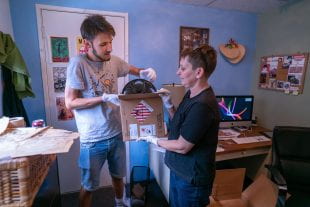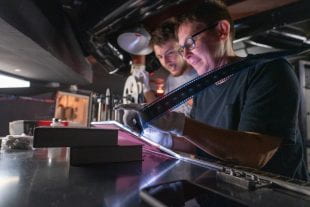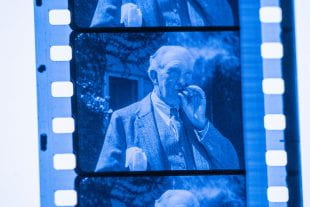Student projects, faculty documentaries and more preserved by cross-departmental archiving project
Only a year ago, the rare films and videos housed in the Rice Media Center were — in the words of Tish Stringer, film program manager and lecturer in the Department of Visual and Dramatic Arts — “in really bad shape.”
A VHS tape has a shelf-life of only 25 years, to say nothing of the stacks of metal film canisters emitting the telltale odor of “vinegar syndrome” that sets in as acetate films decay.
Stringer suspected the footage in the Media Center storage closets — one for films and one for videos — held important historical images. Yet they were buried among 50 years’ worth of accumulated and unorganized media objects, themselves spanning nearly 100 years of film technology and formats from U-matic video cassettes to Laserdiscs.
“I always knew there were gems in there, but I didn’t have time dedicated in my workload to organizing it,” said Stringer, who spent seven summers trying to tackle the monumental task between school years. “The rapid deterioration really lit a fire under us.”
Today, more than 200 of those rare films are in the process of being saved thanks to a cross-departmental project that included support from the School of Humanities, graduate student workers from the Department of Anthropology, librarians and archivists from the Woodson Research Center in Fondren Library and one alum who couldn’t resist the chance to dig through old “home movies” in the Media Center,
Thirty-five are just back from the digitization lab. Now Stringer and her ad hoc team of not-so-amateur film preservationists on the newly named Rice Media Center Film and Video Archive Project have begun sifting through the footage for those gems.
“We found graduations, inaugurations of Rice presidents, Beer Bike from seven different weird years in the 70s and 80s when they were still drinking beer and riding around the quad,” Stringer said.
“It was totally different from what it looks like now,” said anthropology graduate student Baird Campbell.

Graduate student Konstantin Georgiev assists film lecturer Tish Stringer in shipping off rare reels of silver nitrate film found in the Rice Media Center. (Photos and video by Brandon Martin)
Much of Stringer’s team, including Campbell’s fellow grad student Konstantin Georgiev and videoethnographer Michael Adair-Kriz ’10, assembled in the Media Center last week to bid farewell to some incredible reels of highly volatile silver nitrate film from the 1930s found in one of the closets. There was no Rice footage on these films, which were commercial in nature. They were quickly shipped off to The George Eastman Museum in Rochester, New York, for storage and preservation.
There was, however, plenty of found footage from student directors — many of whom, like Amy Hobby, have gone on to become award-winning filmmakers and producers. There was also faculty work documenting the campus and beyond the hedges. There was even film of filmmakers — clips of visiting directors such as Werner Herzog and Jean Rouch showing their documentaries in the Rice Cinema.
There, in recovered celluloid almost lost to time, was a young John Doerr ‘73 working on an engineering class project. There was Chris Kraft, NASA’s first flight director, testing a moon rover with astronauts in full spacesuits, documenting Rice’s long history with the space program.
“This is a truly important and wonderful and understudied piece of Rice University,” said Melissa Kean, the university’s Centennial Historian. “The whole Media Center has really not gotten the kind of attention it deserves, and here’s a piece of it that you can still go back and look at even though some of these things were filmed decades ago.”
Kean was instrumental in involving the Woodson Research Center with the preservation project, along with the help of Woodson colleague and archivist Amanda Focke.
Focke now has 20 terabytes of digitized film and video on a shelf in her office, which represents only a fifth of the entire project. The archiving work — which happens before footage is shipped off to a lab for digitization — includes such important, if repetitious, tasks as making sure the reel of film and the canister itself both bear the same information and ensuring that naming conventions remain consistent across the catalog of content. Thankfully, she said, much of the work was already accomplished by Stringer’s grad students.
Konstantin Georgiev left a successful job in the Eastern European film industry to study anthropology at Rice, and was already familiar with accessing archival films as a result. But being on the other end of things, he said, has been a true learning experience.
“We literally had piles of film that we didn’t know how to catalog or label or make sure that, in two years, the system we were using was still valid,” Georgiev said. “It’s one thing to label the film with its title and director, but this was a whole new world.”
What he came up with met with strong approval from the Woodson — “I’m pretty happy to say they liked our system,” Georgiev said.
Even better, Focke said, the Woodson team also had the chance to learn even more about film preservation from Rice’s own expert on the subject. Wet-transfer film gate versus dry, the visual difference in quality between the two — these were all granular details Focke hadn’t dealt with before.

The projection booth of the Rice Cinema is equipped to show film and video across a wide array of formats.
“We have a basic level of expertise in film and video preservation,” Focke said. “But working with Tish has brought it to a new level, because she really knows a much deeper level of how not to just capture it in a sustainable format, but to get the best possible capture,”
Eventually, the entire catalog of digitized and reclaimed footage of the Rice Media Center Film and Video Archive Project will be available through the Woodson Center. For now, though, Stringer is already ensuring the public can see and learn from these found films.
Every Thursday night at 7 p.m. through the fall semester, the Rice Cinema is screening a fresh batch of rare films in a weekly event Stringer is calling Low-Fi: Analog Deep Cuts from the Archive. It’s as much a mini-film festival as a media literacy seminar, Stringer said, and each evening will begin with a show-and-tell session featuring the actual 16mm films or Betamax tapes to be screened.
Expect to see some long-vanished pieces of Rice history resurrected on screen each Thursday — or perhaps some familiar faces from the past. After all, said Kean, that’s one of the great benefits of moving pictures.
“There’s nothing quite like images,” Kean said. “The power of images to work on peoples’ intellects, on their psyches, on their emotions — I think it’s unparalleled. Images make things real, bring things back to life. Dead people rise. A vanished campus can be seen again.
“That’s powerful,” she said.


